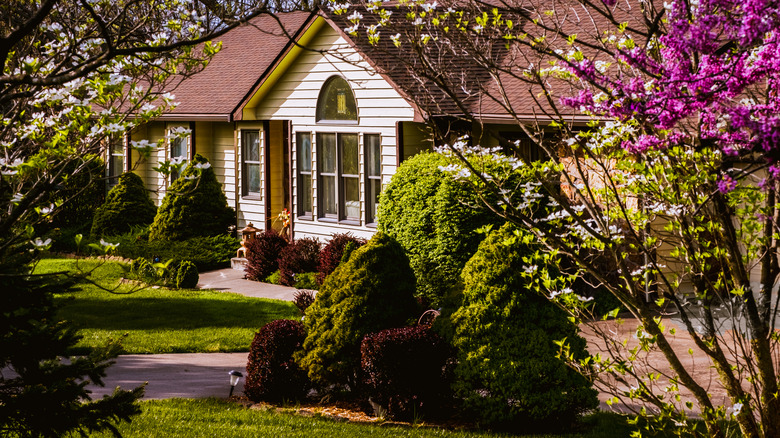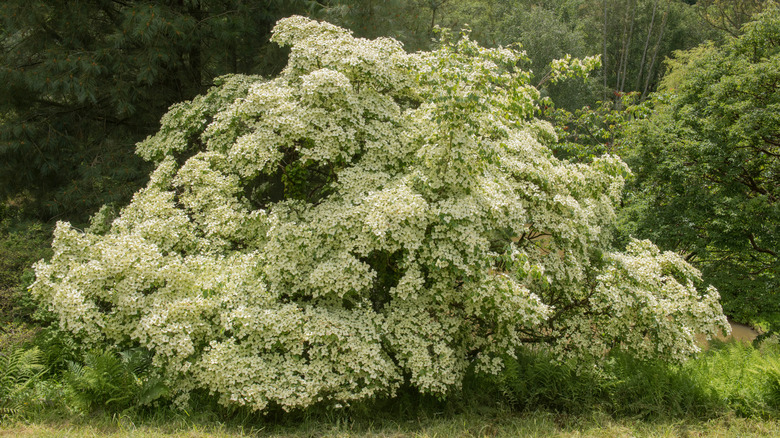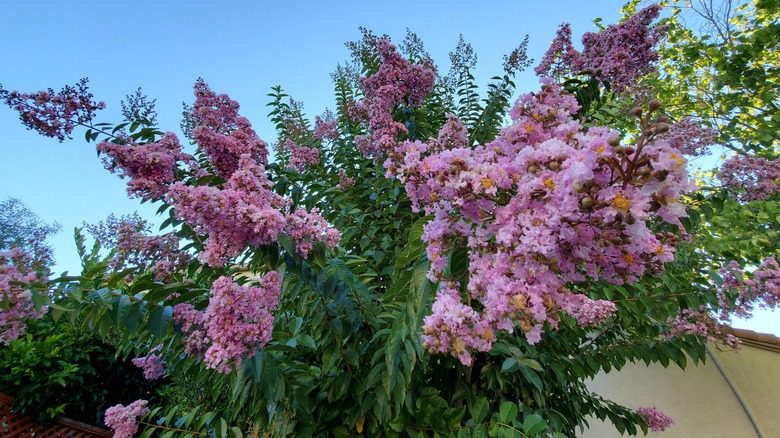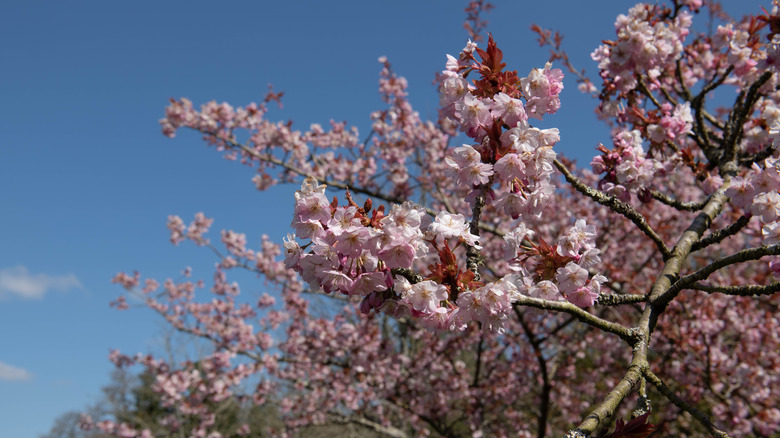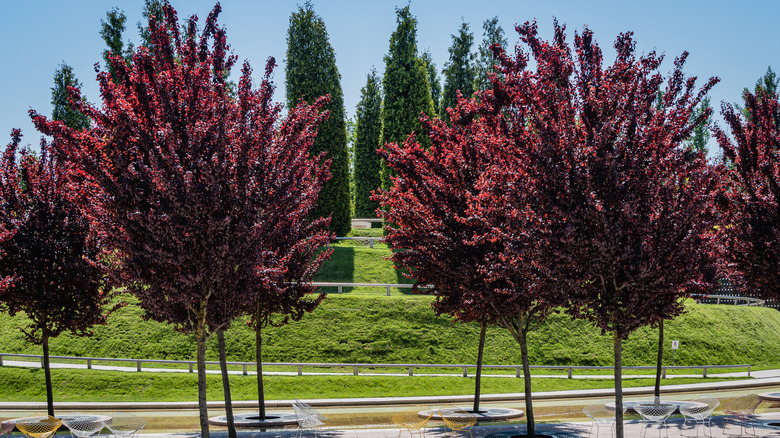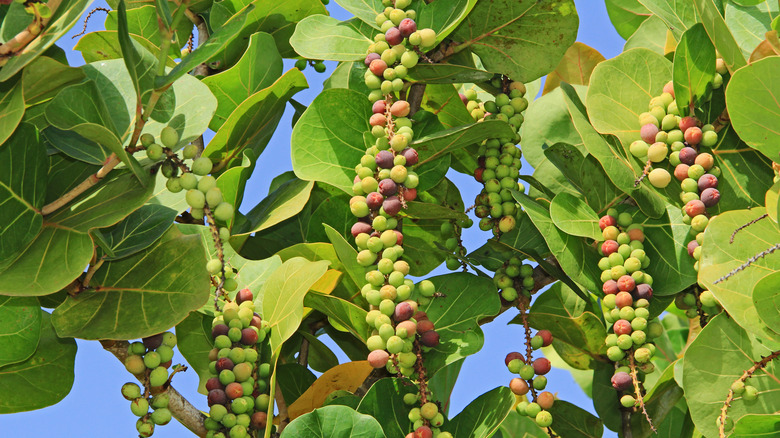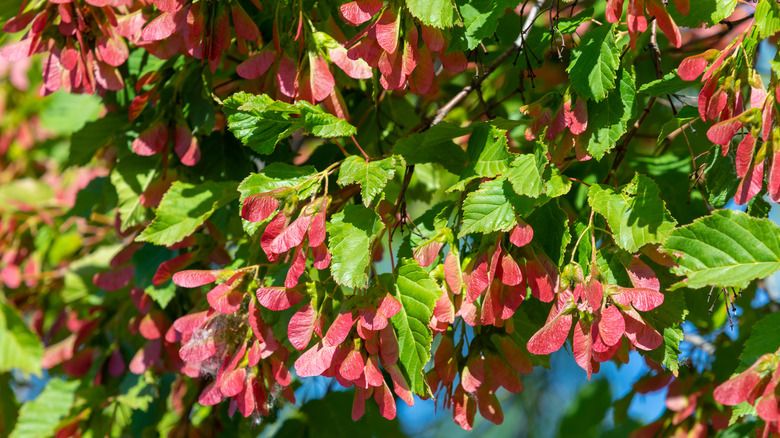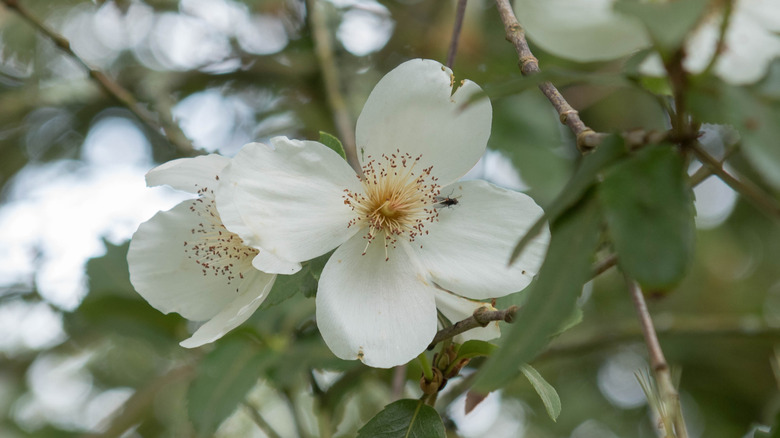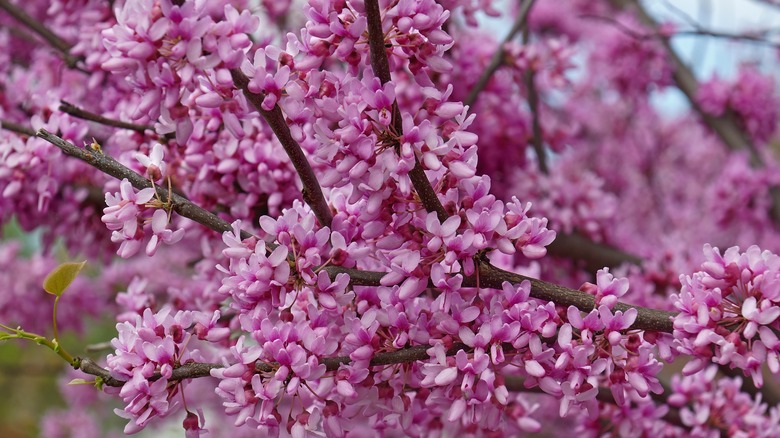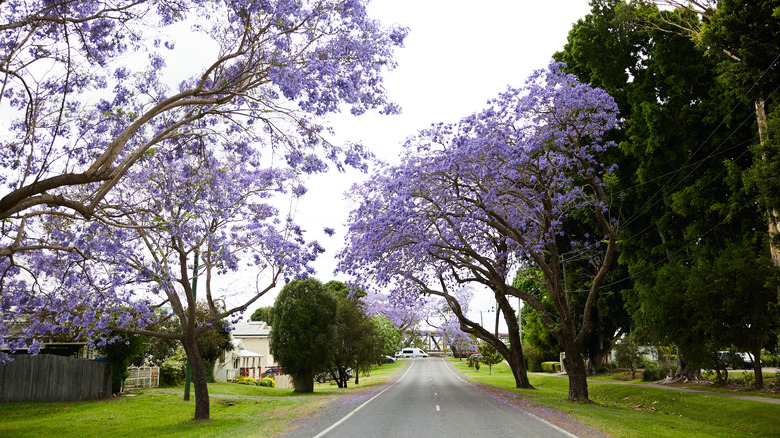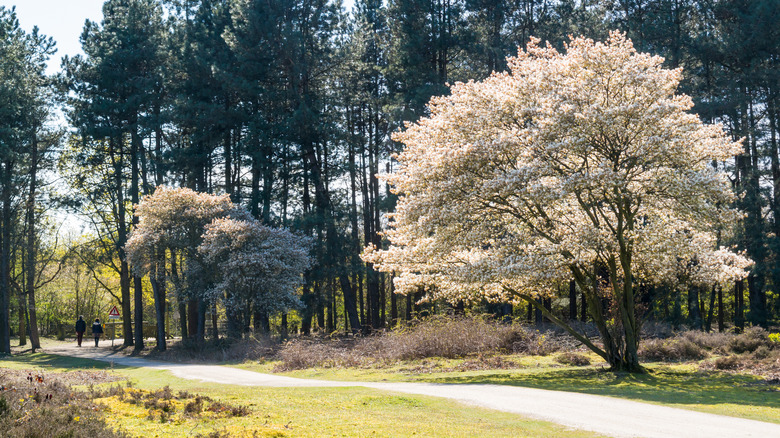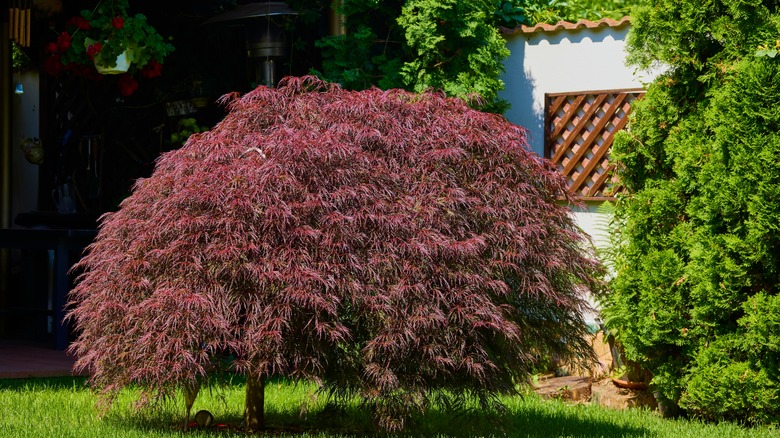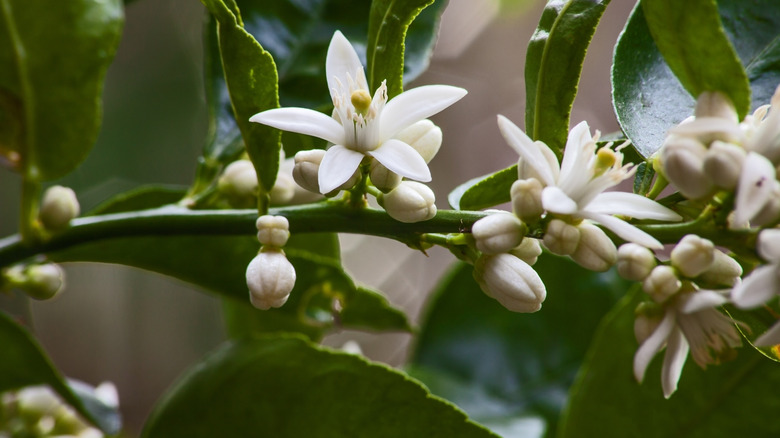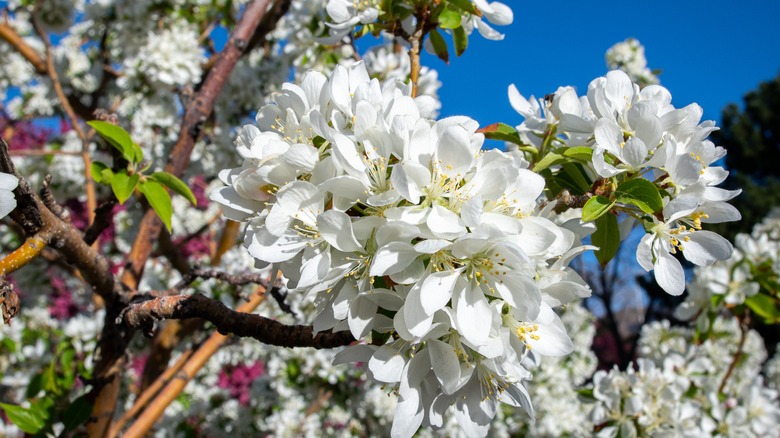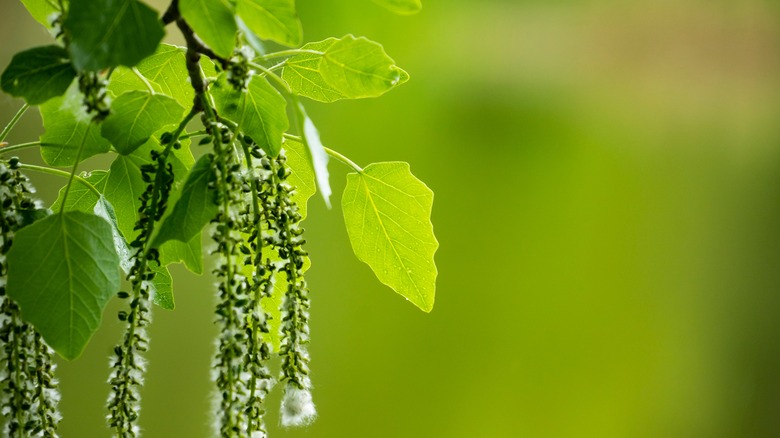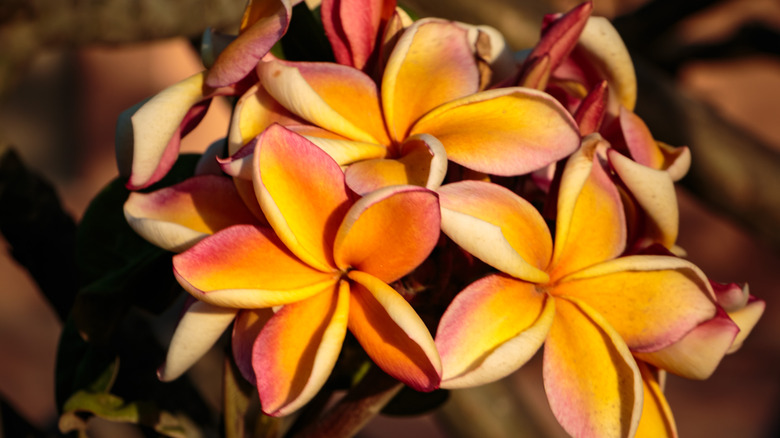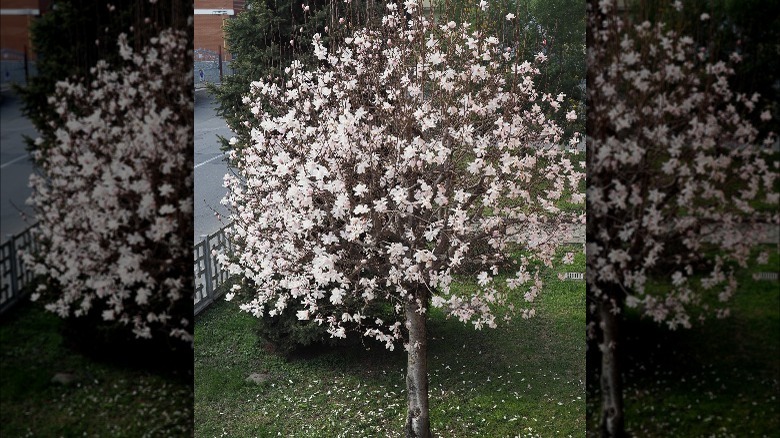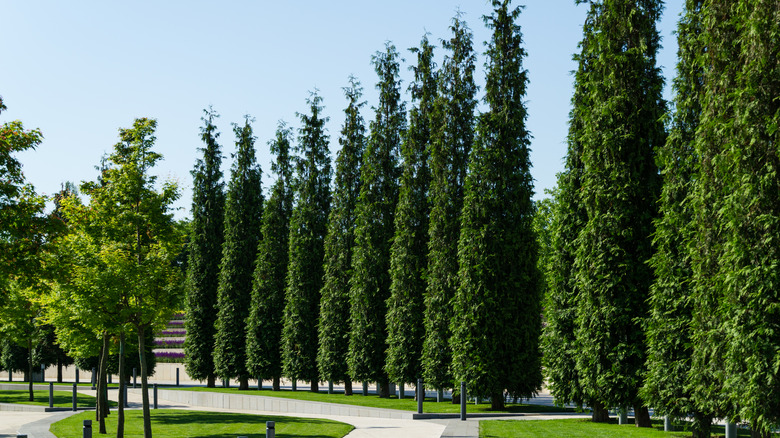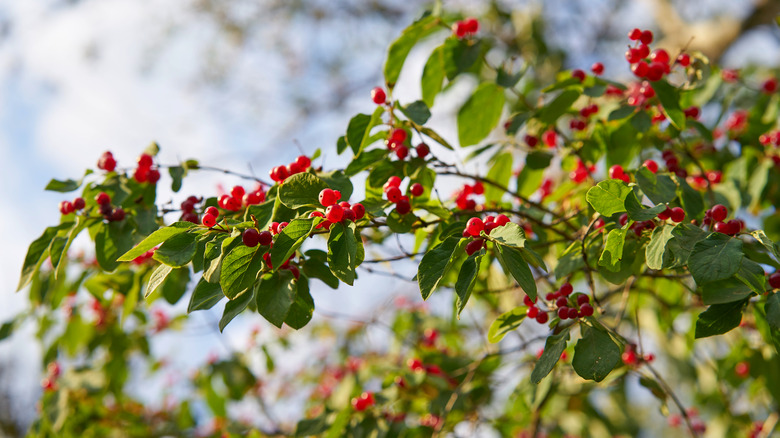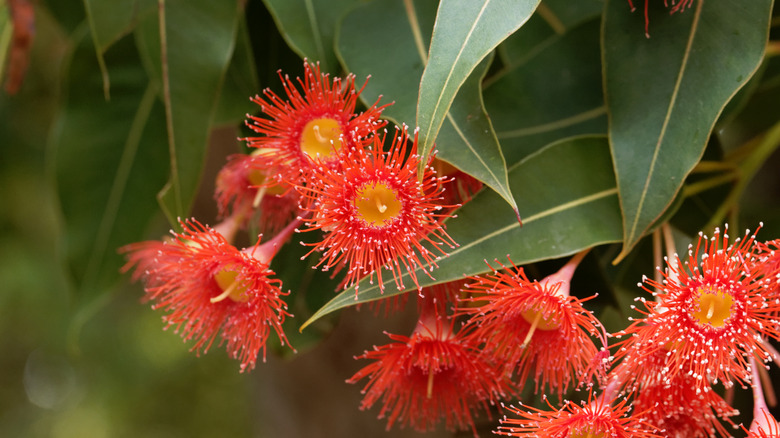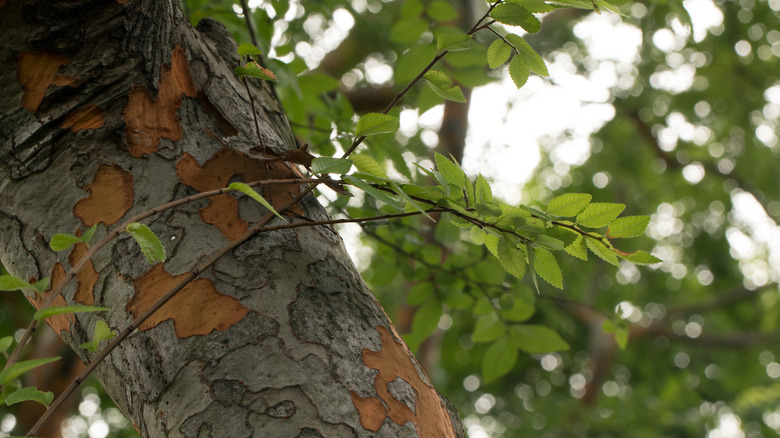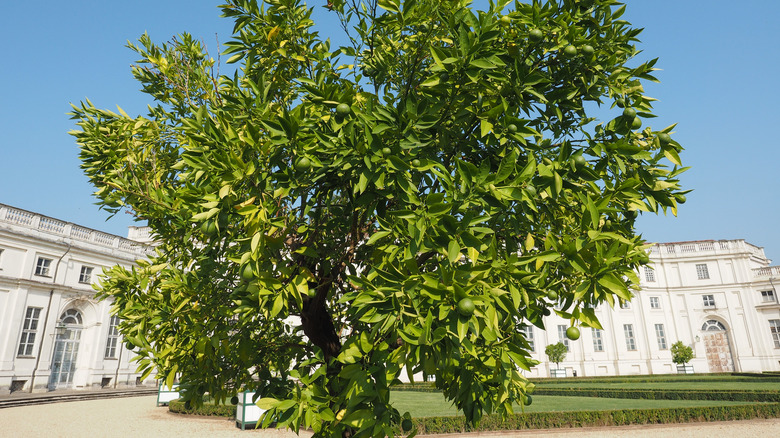Low-Maintenance Trees That You Will Want In Your Landscaping
When it comes to landscaping front and backyards, most people prefer to relieve their future self of tedious outdoor chores and purchase low-maintenance trees. Growing them helps your lawn and garden as they create shade, attract wildlife and beneficial insects, and sometimes produce delicious edible fruit in the summer. You can generally plant these adaptable trees and forget about them for a while until they need some water or light pruning. Yet, you don't have to sacrifice beautiful foliage, interesting shapes, or brightly colored blossoms to grow the best species of citrus trees, maple trees, or trees in the rose family.
In this collection, we gathered many of our favorite no-fuss trees (and some large shrubs) that require almost no maintenance. They are diverse in what they tolerate, so you can choose the best one for your climate and USDA growing zone. From withstanding freezing temperatures to tolerating salty beach locations, there is a tall-growing plant for your yard that will grow happily on its own.
1. Chinese dogwood
Chinese dogwood (Cornus kousa var. chinensis), which is a cultivar of the species commonly called the Kousa dogwood, is a relatively small flowering tree that boasts many white flowers and an attractive vase-like shape. The tree can be quite low-maintenance when you plant and care for it in the right way. Typically, it performs best when it's planted in some shade and given consistent moisture.
Bloom Season: Spring
USDA Growing Zone: 5 to 8
Growing Conditions: Full sun to partial shade
Soil Type: Humusy, organically rich, and well-draining
Size: 15 to 30 feet tall and wide
2. Crape myrtle
Crape myrtle trees (Lagerstroemia indica), which are actually tall-growing deciduous shrubs, are commonly used to create a screen or hedge in warm southern states. Also called Lilacs of the South, they are known for their long bloom season showing off large red, white, pink, and purple blooms. When provided with plenty of sun and warm temperatures, the tree grows with minimal problems and requires little maintenance.
Bloom Season: Summer to fall
USDA Growing Zone: 6 to 9
Growing Conditions: Full sun
Soil Type: Evenly moist and well-draining
Size: 6 to 25 feet tall and wide
3. Fuji cherry
Fuji cherry trees (Prunus incisa) are a tall but narrow species that show off pink flowers during their bloom season. These are perfect for small yards that can't handle large trees as well as for busy people who don't have time for serious maintenance. Even when it's not in bloom, the Fuji cherry tree has some incredible foliage that changes with the season.
Bloom Season: Spring
USDA Growing Zone: 5 to 9
Growing Conditions: Partial to full sun
Soil Type: Evenly moist and well-draining
Size: 5 to 8 feet tall and 3 to 5 feet wide
4. Myrobalan plum
The Myrobalan plum (Prunus cerasifera), which is also referred to as the cherry plum or the purple-leaf plum, is a member of the rose family. It's native to parts of Asia and Europe, but it also grows well in some parts of the US, even naturalizing in some instances. Use them as a focal point to show off fragrant white flowers, and later, sweet fruit in the summertime.
Bloom Season: Spring
USDA Growing Zone: 5 to 8
Growing Conditions: Full sun to partial shade
Soil Type: Well-draining
Size: 15 to 30 feet tall and wide
5. Seagrape
The best thing about the seagrape tree (Coccoloba uvifera) is that most of the time, you can choose whether or not it bears fruit. To produce, female trees must have a male tree nearby. So, if you plant just a single specimen, your tree is unlikely to cross-pollinate. This is helpful for those who are looking for a unique but fruitless gem to grow in their low-maintenance landscape.
Bloom Season: Spring to summer
USDA Growing Zone: 10 to 11
Growing Conditions: Full sun
Soil Type: Well-draining
Size: 35 to 50 feet tall and 20 to 30 feet wide
6. Amur maple tree
Maple species are among the most-loved and stress-free tree options you can get. In particular, the amur maple tree (Acer ginnala) is tolerant of a range of conditions including poor soil, wind, drought, and heavy pruning. You can put this tree through quite a lot and it should continue to grow. Despite its tolerances, the amur maple grows best when planted in full sun with well-draining soil.
Bloom Season: Spring
USDA Growing Zone: 3 to 8
Growing Conditions: Full sun to partial shade
Soil Type: Evenly moist and well-draining
Size: 15 to 20 feet tall and wide
7. Brush bush
The brush bush (Eucryphia nymansensis) may be a difficult tongue twister, but it's incredibly simple to care for. An adaptable species, the evergreen shrub, or tree, is a late-blooming tree that is known for its low-maintenance habit. It's regarded as a no-fuss specimen for border gardens or for architectural planting, yet you should still try to keep it in sunlight and away from drying winds.
Bloom Season: Summer to fall
USDA Growing Zone: 8 to 11
Growing Conditions: Full sun
Soil Type: Evenly moist, fertile, and well-draining
Size: Up to 40 feet tall and 13 feet wide
8. Eastern redbud
The eastern redbud (Cercis canadensis) grows in several U.S. states and produces adorable pink flowers throughout the spring season. If you live on the East Coast, you may already know about the redbud's edible flowers and flower buds that are high in vitamin C. They are delicious on salads, although they can also be cooked into breads and pancakes for their slightly sour taste.
Bloom Season: Spring
USDA Growing Zone: 5 to 9
Growing Conditions: Partial to full shade
Soil Type: Evenly moist, fertile, and well-draining
Size: 15 to 30 feet tall
9. Jacaranda
Jacaranda (Jacaranda mimosifolia), also called black poui, is native to South America where temperatures are consistently well above 20 degrees Fahrenheit. The tree needs relatively high humidity and lots of sunlight to survive. Planted in the correct climate, however, this tropical tree needs little human intervention to thrive. In the summer, it even produces copious blue and purple flowers that are unmatched by any other blooming tree.
Bloom Season: Summer
USDA Growing Zone: 10 to 11
Growing Conditions: Full sun
Soil Type: Sandy, fertile, and well-draining
Size: 25 to 50 feet tall and 15 to 30 feet wide
10. June serviceberry
The June serviceberry (Amelanchier lamarckii), or juneberry tree, is an undemanding deciduous tree or shrub that produces small edible berries that are quite similar to blueberries. These follow fragrant white blooms, which appear in spring. Typically, this tree in the rose family grows best in damp but well-drained loam soil, but it does have a good tolerance for less-than-ideal growing conditions.
Bloom Season: Spring
USDA Growing Zone: 4 to 8
Growing Conditions: Full sun to partial shade
Soil Type: Well-draining
Size: 15 to 25 feet tall and wide
11. Japanese maple
The Japanese maple (Acer palmatum), which is a close relative of the amur maple, can be described as an aesthetically pleasing tree with several different gorgeous varieties. Among the most-favored cultivars are weeping, dwarf, and red-leafed options that work great as specimen plantings or accents around a pathway depending on the variation you choose. One thing they all have in common, however, is their easy-to-grow nature.
Bloom Season: Spring
USDA Growing Zone: 5 to 8
Growing Conditions: Full sun to partial shade
Soil Type: Organically rich and well-draining
Size: 10 to 25 feet tall and wide
12. Olive tree
Olive trees (Olea europaea) are Mediterranean plants that grow best in full sun with not too much water. The trees have low water needs, especially once they've had time to mature. They prefer areas with mild winters and hot summers in areas such as Hawaii and California where they've been deemed invasive. Most often they're grown as ornamental plants, however, you can support cross-pollination if you would like to grow tasty olives.
Bloom Season: Summer
USDA Growing Zone: 8 to 10
Growing Conditions: Full sun
Soil Type: Fertile and well-draining
Size: 20 to 30 feet tall
13. Spring snow crabapple
The spring snow crabapple tree (Malus 'Spring Snow') is most well-known for its fruitless branches that still produce wonderful white flowers in the spring. Busy gardeners love this low-maintenance tree that doesn't require picking up fallen fruit or pruning fast-growing branches. It grows best in full sun with well-draining soil but isn't picky about much else.
Bloom Season: Spring
USDA Growing Zone: 4 to 8
Growing Conditions: Full sun
Soil Type: Evenly moist, acidic, and well-draining
Size: 20 to 25 feet tall and 15 to 20 feet wide
14. Japanese gray birch
Also known as the Japanese cherry birch, the Japanese gray birch (Betula pendula) is unlike many of the other trees on this list. It grows best in the colder northern areas such as on the Canadian border. When the fast-growing birch tree's roots are kept cool, it produces amazing bark and foliage that is instantly recognizable.
Bloom Season: Spring
USDA Growing Zone: 4 to 7
Growing Conditions: Full sun to partial shade
Soil Type: Evenly moist, acidic, and well-draining
Size: 20 to 25 feet tall and wide
15. Frangipani
Frangipani (Plumeria spp.) is a genus of tropical shrub and tree species that can sometimes reach tall heights depending on the cultivar. The small trees need warm weather, high humidity, and direct sunlight to survive and bear their fragrant flowers. Likely, you will recognize the Frangipani flowers, which are commonly used for making perfume and leis.
Bloom Season: Summer to fall
USDA Growing Zone: 10 to 12
Growing Conditions: Full sun
Soil Type: Evenly moist and well-draining
Size: Up to 20 feet tall and wide
16. Sweetbay magnolia tree
Sweetbay magnolia trees (Magnolia virginiana) are long-bloomers in the South. They can be deciduous or evergreen depending on the cultivar. Grow sweetbay magnolias almost anywhere in your landscape; they are not too picky about the soil they are grown in as long as it's plenty moist. With good care, you'll be rewarded with attractive foliage and scented flowers.
Bloom Season: Spring and summer
USDA Growing Zone: 5 to 9
Growing Conditions: Full sun to partial shade
Soil Type: Evenly moist and well-draining
Size: 40 to 50 feet tall and 15 to 25 feet wide
17. Green giant arborvitae
The green giant arborvitae (Thuja standishii x plicata) is one of the best low-maintenance trees to plant as a hedge or a screen. The fast-growing hybrid species is resistant to an array of environmental challenges such as winds, heavy snow, and freezing weather. On the other hand, it shouldn't be grown near salty beaches or in hot climates that frequently experience temperatures in the 90 to 100 degree Fahrenheit range.
USDA Growing Zone: 5 to 7
Growing Conditions: Full sun to partial shade
Soil Type: Well-draining
Size: Up to 60 feet tall and 20 feet wide
18. Yaupon holly
Yaupon holly (Ilex vomitoria), like green giant arborvitae, can be used as a screen, hedge, or even a topiary. A member of the Holly family, this tree produces small bright red berries and little green leaves. It is also adaptable to a range of soils and doesn't mind some flooding, drought, or salt. You choose how maintenance-intensive you want your tree to be.
Bloom Season: Spring
USDA Growing Zone: 7 to 9
Growing Conditions: Full sun to deep shade
Soil Type: Well-draining
Size: 10 to 20 feet tall and 8 to 12 feet wide
19. Flowering gum
Flowering gum (Corymbia ficifolia) is a fast-growing tree that shows off clusters of orange, pink, or red blooms periodically over the years. Native to Australia, it grows well in the warmest parts of the United States, including California, Arizona, and southern Florida. Flowering gum is well-loved for its fragrant leaves and low-maintenance habit when grown in the correct climate.
Bloom Season: Year-round
USDA Growing Zone: 9 to 11
Growing Conditions: Full sun
Soil Type: Evenly moist and well-draining
Size: 25 to 40 feet tall and wide
20. Chinese elm
The Chinese elm (Ulmus parvifolia) is frequently used as a street tree or a shade tree in its native regions of China, Japan, and Korea. Also known as the lacebark tree, it is accustomed to growing in bright direct sunlight, although it can grow in somewhat shady locations. The tall tree is popular due to its resistance to common plant diseases and its tolerance to inferior soil and urban conditions.
Bloom Season: Summer
USDA Growing Zone: 4 to 9
Growing Conditions: Full sun
Soil Type: Fertile and well-draining
Size: Up to 50 feet tall and 40 feet wide
21. Tahitian lime
Tahitian limes (Citrus x latifolia) are a hybrid species of warm-weather trees that bear seedless limes on arching branches. If you were to grow it, it would require minimal maintenance once planted in a full-sun location. Though, keep in mind, it needs moist soil and some fertilization to grow properly and produce its delicious fruit.
Bloom Season: Winter to spring
USDA Growing Zone: 9 to 11
Growing Conditions: Full sun
Soil Type: Evenly moist and well-draining
Size: 8 to 20 feet tall and wide
